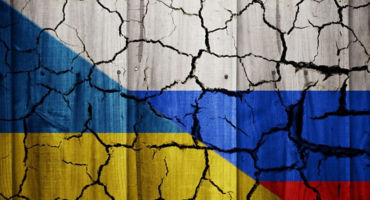Skip to main content
- Insights
- Sustainability
- About Us
- Careers
- My Account
Formats
Sustainable Investing
Stewardship Principles
Investment Solutions
The views expressed are those of the author at the time of writing. Other teams may hold different views and make different investment decisions. The value of your investment may become worth more or less than at the time of original investment. While any third-party data used is considered reliable, its accuracy is not guaranteed.
Amid the geopolitical turmoil and tragic humanitarian fallout of the Russia/Ukraine crisis, many investors are naturally also concerned about the negative effects the escalating conflict could have on their portfolios. With that in mind, I thought I’d provide a quick snapshot of the impacts that past wars have tended to have on asset prices. From a historical perspective, I found three points in particular worth highlighting:
In the interest of full disclosure, of these three points, I am most confident about the first one as of this writing. In any case, based on the evidence at hand, I’m not taken aback that US financial markets have not gone totally haywire in response to the crisis. All things considered, they’ve actually been relatively calm. My key takeaway for investors is that, if history is any guide, it’s not clear to me that the current conflict implies now is an especially good time to be buying risky assets.
In US equity market history, there has often been surprisingly little market impact from wars, other conflicts, and assassinations. As shown in a 1989 article by Cutler, Poterba, and Summers, most large daily moves in US stock prices (such as the October 1987 market crash) have not been triggered by obvious exogenous (and usually unforeseen) news shocks.
For example, the US stock market fell only 4% the day after the 7 December 1941 Pearl Harbor attack and only 3% the day after President John F. Kennedy was assassinated in November 1963 (Figure 1). A follow-up article by Bradford Cornell reached similar conclusions, noting that US stock prices dropped only 5% when the market reopened after the horrific events of 11 September 2001.
In addition, a study by Baker, Bloom, Davis, and Sammon found that only 9% of the large moves in US stocks from 1900 to 2020 have been associated with “sovereign military and security actions,” with much of that price action occurring around the time of World War I and very little coming from either the Korean War or the Vietnam War.
Turning to global equities and US fixed income, again we find fairly small impacts from war and conflict, with the Baker, Bloom, Davis, and Sammon study reporting that only 3% – 4% of the big price moves in non-US stock market history and only 1% of such moves in US bond markets have been driven by such “sovereign military and security actions.
However, if a war or conflict ultimately results in the collapse of a country and/or its economy, that outcome is rarely good news for investors in the country’s stocks and bonds (read: Confederate States of America when the US Civil War ended in 1865). A 2008 Ferguson article cites several prominent historical examples, including how investors in German equities did not fare well after both of the two twentieth-century world wars that Germany lost.
Moreover, even if a country winds up “winning” a war or at least not losing it, the country (along with its asset prices) may still find itself in quite poor shape post-conflict. For instance, investors in British bonds struggled mightily both during and following World War I. As Ferguson writes:
Investors try to learn from history, but the very different financial impacts of the two world wars and the Cold War reveal the tendency of military technology and regulatory regimes to shift significantly, reducing the relevance of past experience. Any lessons investors might take from the last war could have limited relevance for the next — or be forgotten after a generation of relative peace has led to complacency.
Allegedly said in 1810 by financier Nathan Rothschild: “Buy on the sound of cannons, sell on the sound of trumpets.” Certainly said more recently by superinvestor Warren Buffett: “Be fearful when others are greedy and greedy when others are fearful.”
I cannot bring a ton of insight to this topic right now, but as far as I can tell, it does not appear to be generally true that when country ABC goes to war, its stock market will be a “good value” with a high likelihood of performing strongly going forward. A 2010 Berkman, Jacobsen, and Lee study created a “crisis index” showing that while US stock prices often look cheap in times of heightened global crisis, that typically has not translated into a subsequent reality of high returns to investors.
One obstacle here is that the available data does not include very many observations of full-scale war. (Figure 2 shows that across 167 nations from 1918 – 2006, there was only a 1.35% chance that a given country in a given year would be embroiled in an all-out war.) At any rate, the Berkman, Jacobsen, and Lee research demonstrates that situations like Russia/Ukraine — a severe crisis involving a major world power — have more of an impact on global equity markets when they first break out, but what it does not do is present any convincing evidence that such conflicts spawn buying opportunities for investors.
Investing in the age of great-power competition
As competition between great powers intensifies, a new global order is taking shape. Geopolitical Strategist Thomas Mucha explores the investment implications of a more fragmented and fractious world.
Russia/Ukraine: One year in with no end in sight
Geopolitical Strategist Thomas Mucha analyzes the impacts of the Russia/Ukraine conflict one year in and identifies potential longer-term effects.





URL References
Related Insights
Past results are not necessarily indicative of future results and an investment can lose value. Funds returns are shown net of fees. Source: Wellington Management
© 2023 Morningstar, Inc. All Rights Reserved. The information contained herein: (1) is proprietary to Morningstar; (2) may not be copied or distributed; and (3) is not warranted to be accurate, complete or timely. Neither Morningstar nor its content providers are responsible for any damages or losses arising from any use of this information. The Overall Morningstar Rating for a fund is derived from a weighted average of the three, five, and ten year (if applicable) ratings, based on risk-adjusted return. Past performance is no guarantee of future results.
The content within this page is issued by Wellington Management Singapore Pte Ltd (UEN: 201415544E) (WMS). This advertisement or publication has not been reviewed by the Monetary Authority of Singapore. Information contained on this website is provided for information purposes and does not constitute financial advice or recommendation in any security including but not limited to, share in the funds and is prepared without regard to the specific objectives, financial situation or needs of any particular person.
Investment in the funds described on this website carries a substantial degree of risk and places an investor’s capital at risk. The price and value of investments is not guaranteed. The value of the shares of the funds and the income accruing to them, if any, and may fall or rise. An investor may not get back the original amount invested and an investor may lose all of their investment. Investment in the funds described on this website is not suitable for all investors. Investors should read the prospectus and the Product Highlights Sheet of the respective fund and seek financial advice before deciding whether to purchase shares in any fund. Past performance or any economic trends or forecast, are not necessarily indicative of future performance. Some of the funds described on this website may use or invest in financial derivative instruments for portfolio management and hedging purposes. Investments in the funds are subject to investment risks, including the possible loss of the principal amount invested. None of the funds listed on this website guarantees distributions and distributions may fluctuate and may be paid out of capital. Past distributions are not necessarily indicative of future trends, which may be lower. Please note that payment of distributions out of capital effectively amounts to a return or withdrawal of the principal amount invested or of net capital gains attributable to that principal amount. Actual distribution of income, net capital gains and/or capital will be at the manager’s absolute discretion. Payments on dividends may result in a reduction of NAV per share of the funds. The preceding paragraph is only applicable if the fund intends to pay dividends/ distributions. Performance with preliminary charge (sales charge) is calculated on a NAV to NAV basis, net of 5% preliminary charge (initial sales charge). Unless stated otherwise data is as at previous month end.
Subscriptions may only be made on the basis of the latest prospectus and Product Highlights Sheet, and they can be obtained from WMS or fund distributors upon request.
This material may not be reproduced or distributed, in whole or in part, without the express written consent of Wellington Management.